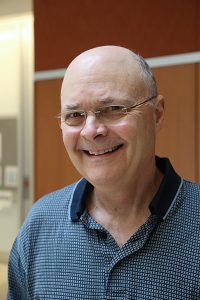Molecular biologist Jordi Xiol posted a fascinating entry on his Substack page “Vineyard Books, a blog on history and science,” featuring UNC School of Medicine’s Charles Carter, PhD, professor of biochemistry and biophysics, and his research into the proteins that spurred life on Earth four billion years ago.

Below is an excerpt titled “Adam and Eve Existed: They Created the Genetic Code,” from Vinyard Books, a Blog on History and Science by Jordi Xiol, a molecular biologist. The blog might be blocked on devices issued by UNC Health, but it is a legitimate external site, and the post is a fascinating look into the history and science of origins of life on Earth.
–How did life on Earth begin? Recent scientific advances suggest that all living beings are descended from a single gene that existed around 4 billion years ago. This gene produced two proteins that created the genetic code, the universal language of life that marks the separation from the inanimate world. The scientists who discovered these proteins, recognizing their central role at the dawn of existence, gave them familiar names: Adam and Eve.
Darwin’s Promise: A Path to the Origin
“God is dead. God remains dead. And we have killed him. How shall we console ourselves, the murderers of all murderers?”1 German philosopher Friedrich Nietzsche wrote these words a decade after a new scientific theory shook the prevailing religious dogma to its core. In his 1871 book The Descent of Man, English naturalist Charles Darwin openly defied the Biblical narrative of Adam and Eve: human beings could not have been created directly by God in the Garden of Eden, because they were the product of evolution and shared a common ancestor with apes2. In the context of the origin of life, Nietzsche’s statement was eerily accurate: Adam and Eve were dead, and Darwin was the executioner.
The void left by Adam and Eve’s demise was occupied by a tantalizing promise. Darwin’s theory established a familial link between all organisms, which would mean—in his own words—that “probably all the organic beings which have ever lived on this Earth have descended from some one primordial form, into which life was first breathed.”3 If the evolutionary tree could be traced back to its very root, such was the promise, the secret of the origin of life would be revealed.
Advances in molecular biology in the second half of the 20th century validated Darwin’s hypothesis. The common origin was beyond any reasonable doubt: all organisms without exception use the genetic code, a code so universal yet so complex that it is impossible to envision it emerging multiple times independently. To perform their essential functions, all cells need to make proteins that are encoded in DNA sequences; the genetic code is the language that translates the genetic information from the four-letter alphabet of DNA to the twenty-letter alphabet of proteins. During evolution, natural selection acts on small changes in the sequence of DNA that accumulate as they are passed from generation to generation. The genetic code, however, has remained almost unchanged since the first microbes began to populate the Earth. Species evolve, but the code is an immutable facilitator. Any attempt to decipher the origin of life must address this question: how did the code that enables everything else come to be?
The answer is present, like a living fossil, in every cell of every living creature on the planet. It remained encrypted until 1995, when pioneering scientists Sergei Rodin and Susumu Ohno followed Darwin’s trail to its very end and found a singular ancestral gene simultaneously coding for two proteins in a perfectly complementary manner. Brilliant but esoteric, the Rodin-Ohno hypothesis faded into obscurity until the laboratory of Charles Carter, an obstinate American biochemist, demonstrated it experimentally two decades later. Biblical Adam and Eve had fallen, but at the end of the Darwinian path that replaced them lay an equally mystical and fascinating duo: molecular Adam and Eve, the proteins that created the genetic code.–